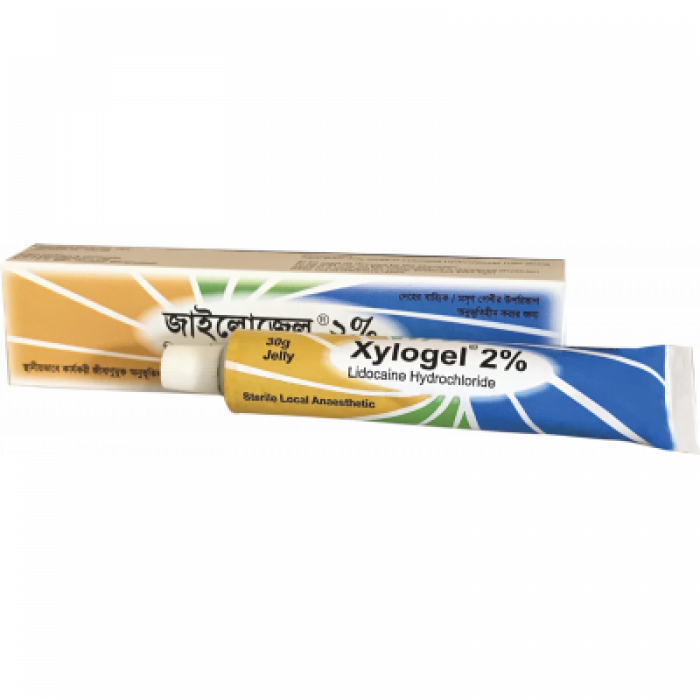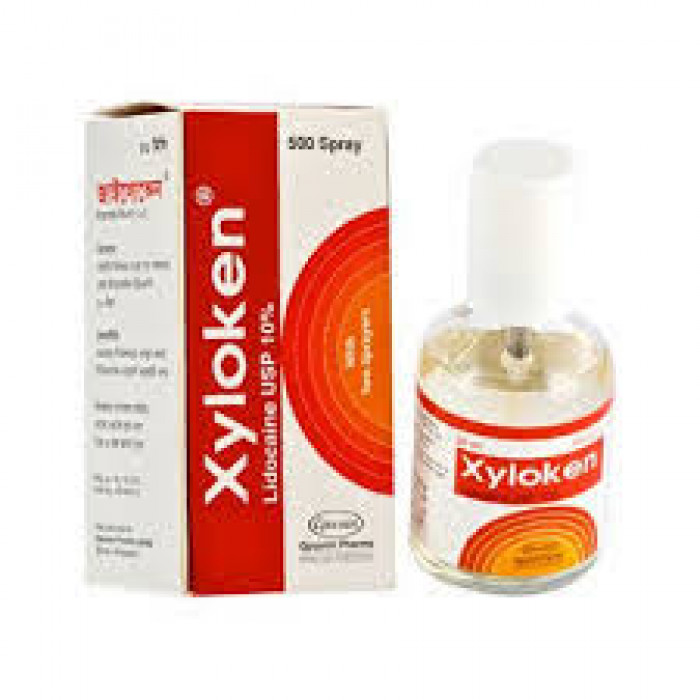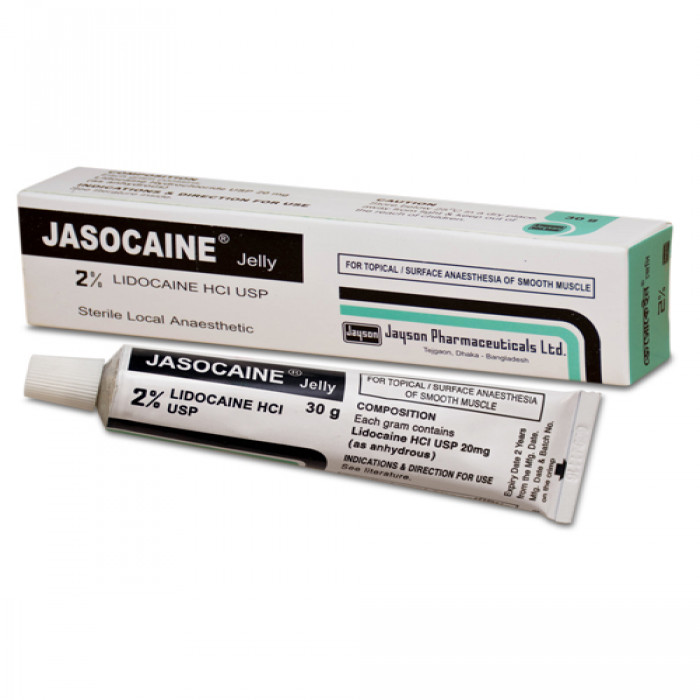
✔ 100% Authentic Product
👁️ Currently Viewing 6555
Jasocaine 2% Jelly 30gm
Jasocaine 2% Jelly is a local anesthetic that is used to numb specific areas of the body temporarily. It is used as an anesthetic lubricant in medical procedures to insert instruments into the human body (e.g., catheters). It is also used to treat the symptoms of painful inflammation of the urethra in the topical treatment of painful urethritis.
Discount
Price: ৳ 98
MRP:
৳
100
2%
Off

100% Genuine Products, Guaranteed

Safe & Secure Payments, Always

Fast, Secure & Efficient Delivery

Proper Packaging
 Cash on Delivery - All over Bangladesh
Cash on Delivery - All over Bangladesh Regular Delivery - 12-24 Hours, Dhaka City* Charge Tk.39-59
Regular Delivery - 12-24 Hours, Dhaka City* Charge Tk.39-59 Regular Delivery - 24-48 Hours, Other Cities* Charge Tk.99-110
Regular Delivery - 24-48 Hours, Other Cities* Charge Tk.99-110
 ফ্রি ডেলিভারিঃ - ৯৯৯ টাকা+ অর্ডারে, ঢাকা
শহরে
ফ্রি ডেলিভারিঃ - ৯৯৯ টাকা+ অর্ডারে, ঢাকা
শহরে ফ্রি ডেলিভারিঃ - ২৯৯৯ টাকা+ অর্ডারে, ঢাকার
বাহিরে
ফ্রি ডেলিভারিঃ - ২৯৯৯ টাকা+ অর্ডারে, ঢাকার
বাহিরে
100% Genuine Products, Guaranteed
Safe & Secure Payments, Always
Fast, Secure & Efficient Delivery
Proper Packaging
 Cash on Delivery - All over Bangladesh
Cash on Delivery - All over Bangladesh Regular Delivery - 12-24 Hours, Dhaka City* Charge Tk.39-59
Regular Delivery - 12-24 Hours, Dhaka City* Charge Tk.39-59 Regular Delivery - 24-48 Hours, Other Cities* Charge Tk.99-110
Regular Delivery - 24-48 Hours, Other Cities* Charge Tk.99-110 ফ্রি ডেলিভারিঃ - ৯৯৯ টাকা+ অর্ডারে, ঢাকা
শহরে
ফ্রি ডেলিভারিঃ - ৯৯৯ টাকা+ অর্ডারে, ঢাকা
শহরে ফ্রি ডেলিভারিঃ - ২৯৯৯ টাকা+ অর্ডারে, ঢাকার
বাহিরে
ফ্রি ডেলিভারিঃ - ২৯৯৯ টাকা+ অর্ডারে, ঢাকার
বাহিরে
✅ Description:
Jasocaine 2% Jelly (Lidocaine Hydrochloride) is a local anesthetic that belongs to a class of drugs used to alleviate pain and discomfort associated with various skin conditions such as irritation, burns, scratches, insect bites, abrasions, and sunburn. It can also be used to treat lasting pain after a shingles infection, or premature ejaculation, and to prevent and control pain in urethritis. Additionally, Jasocaine 2% Jelly may serve as an adjunct for endotracheal intubation.
The active ingredient in Jasocaine 2% Jelly is 'Lidocaine', which works by blocking sodium ions from entering the nerve membrane, thus preventing the initiation and transmission of nerve signals. This results in localized numbness and a reduction in pain sensation.
Follow your doctor's instructions when using Jasocaine 2% Jelly. It is possible to experience mild side effects at the application site, such as a burning sensation, itching, redness, or irritation. Typically, these side effects are not serious and will resolve on their own. However, if they persist, it is advisable to consult your doctor.
If you are pregnant or breastfeeding, it is important to consult your doctor before using Jasocaine 2% Jelly. The safety and effectiveness of the gel in children have not been established, so caution is advised. Avoid contact with the eyes, nose, or mouth when applying the gel, and rinse with water immediately if contact occurs. Refrain from applying the gel to swollen skin areas or deep puncture wounds. Inform your doctor about your medical condition and other medications to ensure there are no potential side effects or interactions.
Safety Advices
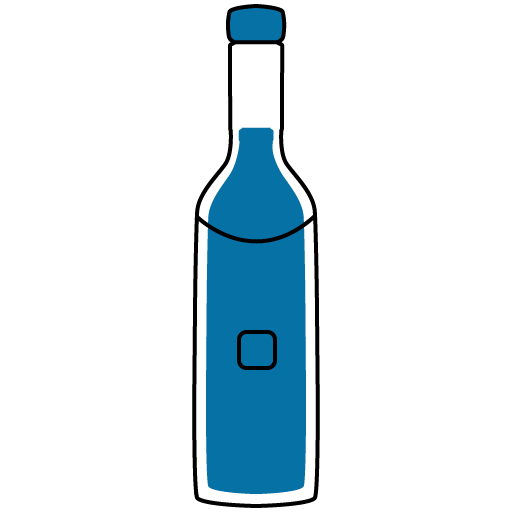
Alcohol
CAUTION
It is unknown if alcohol affects Jasocaine 2% Jelly. Please consult your doctor if you have any concerns.

Pregnancy
CAUTION
Jasocaine 2% Jelly can be used in pregnant women if considered necessary. However, consult your doctor for advice before using it.
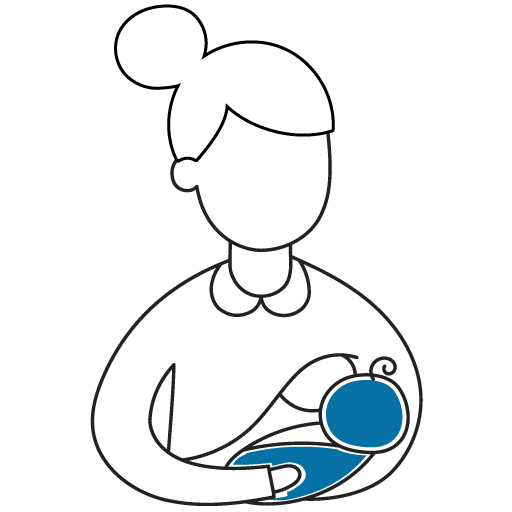
Breastfeeding
CAUTION
Jasocaine 2% Jelly can be used in breastfeeding women if considered necessary. However, consult your doctor for advice before using it.

Driving
CAUTION
It is not known if Jasocaine 2% Jelly affects your ability to drive. Drive only if you are alert after using Jasocaine 2% Jelly.
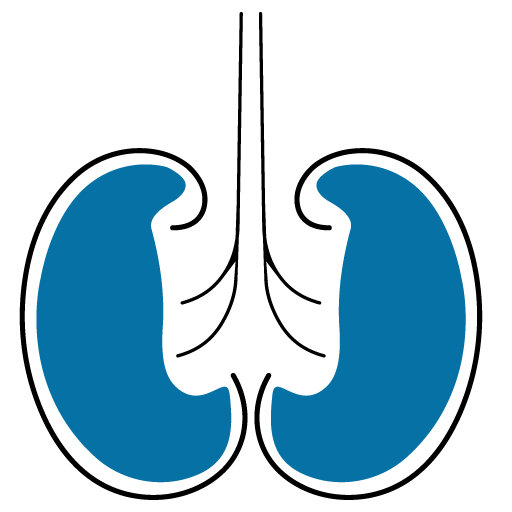
Kidney
CAUTION
Jasocaine 2% Jelly should be used with caution in patients with kidney diseases. Therefore, consult your doctor before applyingJasocaine 2% Jelly.

Liver
CAUTION
Jasocaine 2% Jelly should be used with caution in patients with liver diseases. Therefore, consult your doctor before applying.
✔️ Uses of Jasocaine 2% Jelly
- Pain and irritation
- Local anesthesia
✔️ How Jasocaine 2% Jelly works?
Use of Jasocaine 2% Jelly must be regulated by a qualified medical professional. The doctor in charge of the area where anesthesia is necessary administers it. If directed to do so by the doctor, people can also give it themselves.
Apply a tiny amount of the Jasocaine 2% Jelly to the necessary places. Stay away from getting Jasocaine 2% Jelly in your eyes.
Depending on your age, weight, health, and the body parts where numbness is needed, your doctor will choose the appropriate treatment dose and duration for you.
✔️ Side Effects of Jasocaine 2% Jelly
- Flushing or redness of the skin
- Skin rash
- Allergic reaction
- Cracked or scaly skin
- Swelling of face, lips, eyelids, tongue, hands and feet
- Nervousness
- Shaking and trembling of arms and feet
✔️ Quick Suggestions:
- Jasocaine 2% Jelly is prescribed to relieve itching and pain caused by scrapes, burns, rashes, bites, and eczema.
- Apply it over the affected area with a clean fingertip, three to four times a day or as directed by your doctor.
- Do not apply it to broken or infected areas of skin, face, eyes, or eyelids unless instructed to by your doctor.
- Do not cover the area being treated with airtight dressings such as bandages unless directed by a doctor, as this may increase the risk of side effects.
- Avoid contact with eyes, mouth, and nose. In case of accidental contact, rinse thoroughly with water.
- Consult your doctor if your skin condition has not improved after 2-4 weeks of treatment.
- Inform your doctor if you are pregnant, planning pregnancy, or breastfeeding.
✔️ Indication of Jasocaine 2% Jelly
Jasocaine 2% Jelly causes numbness and provides temporary relief of pain, itching, and discomfort associated with:
- Skin abrasions, sunburns, insect bites, sore nipples
- Shingles, bed sores, and cold sores
- Hemorrhoids (piles), anal fissures, pruritus ani (itching of the anus)
- Pruritus vulvae (itching of female genitalia)
- Circumcision (a surgery that removes the foreskin from the human penis) in children
- Oral sores and dental procedures (such as scaling or denture fixing)
- Invasive procedures (such as insertion of catheters or intubation tubes)
- Diagnostic procedures (such as proctoscopy, rectoscopy, cystoscopy, gastroscopy, bronchoscopy, esophagoscopy, etc.)
✔️ Pharmacology
Lidocaine primarily works by inhibiting the influx of sodium ions through voltage-gated sodium channels in neuronal cell membranes. By blocking the sodium channels, lidocaine prevents the generation and conduction of action potentials. The binding site of lidocaine is believed to be located in the cytoplasmic region of the sodium channel. Lidocaine has a higher affinity for sodium channels in the activated state, resulting in a faster onset of the neuronal blockade, especially in rapidly firing neurons. This phenomenon is commonly referred to as a state-dependent blockade.
✔️ Dosage & Administration of Jasocaine 2% Jelly
- Urethral anesthesia: For surface anesthesia of the male adult urethra, a dosage of 400 mg is required for effective pain relief.
- For surface anesthesia of the female adult urethra, instill 100-200 mg of the product in small portions to fill the entire urethra. It is important to wait several minutes before performing any urological procedures to achieve adequate anesthesia.
- For lubrication during endotracheal intubation, apply 100 mg of the product on the surface of the tube just before insertion. Take care to avoid introducing the product into the lumen of the tube.
- During endoscopy, it is recommended to instill 200-400 mg of the product for adequate pain relief. Additionally, a small amount can be applied to the instrument for lubrication. Debilitated, elderly patients and children should receive doses appropriate for their age and physical condition.
- Intravenous (IV) Preparation: Add 1-2 g of lidocaine hydrochloride to 1 L of D5W to make a 1-2 mg/mL solution. Alternatively, you can use 5-10 mL of a 20% injection solution. Concentrations of 400 mg/100 mL in D5W or 800 mg/100 mL in D5W at 8 mg/mL have been recommended for fluid-restricted patients.
- Intravenous for Ventricular Arrhythmias: Administer 1-1.5 mg/kg slowly as an IV bolus over 2-3 minutes. Repeat doses of 0.5-0.75 mg/kg can be given every 5-10 minutes up to a maximum total dose of 3 mg/kg. Continuous infusion at a rate of 1-4 mg/min can also be used.
- Regional Anesthesia (IV): Administer 4 mg/kg.
- Sympathetic Nerve Block: For the cervical block, administer 50 mg or 50-100 mg for the lumbar block as a 1% solution.
- Epidural: Administer 2-3 mL for each dermatome to be anesthetized. Recommended doses are as follows: 250-300 mg (1% solution) for lumbar epidural analgesia, 225-300 mg (1.5% solution) or 200-300 mg (2% solution) for lumbar epidural anesthesia, and 200-300 mg (1% solution) for thoracic epidural anesthesia. For obstetric caudal analgesia, administer 200-300 mg (1% solution), and for surgical caudal anesthesia, administer 225-300 mg (1.5% solution). Do not exceed the maximum recommended doses more frequently than every 1.5 hours for continuous epidural or caudal anesthesia.
- Peripheral Nerve Block: The recommended doses are as follows: 225-300 mg (1.5% solution) for brachial plexus block, 20-100 mg (2% solution) for dental nerve block, 30 mg (1% solution) for intercostal nerve block, 100 mg on each side (1% solution) not more frequently than every 90 minutes for paracervical block, 30-50 mg (1% solution) for paravertebral block, and 100 mg on each side (4% solution) for the pudendal block. For retrobulbar block, administer
Please note that the applicator should be sterilized in boiling water for 5 minutes, cooled, and then attached to the tube. The gel should be instilled slowly as needed. After each use, detach the applicator and keep the tube tightly closed.
✔️ Interaction
Cimetidine and propranolol may increase serum levels of lidocaine. There is an increased risk of cardiac depression when lidocaine is used in combination with beta-blockers and other antiarrhythmic medications. IV phenytoin can have additive cardiac effects when used with lidocaine. Hypokalemia caused by acetazolamide, loop diuretics, and thiazides may counteract the effectiveness of lidocaine. Dose requirements of lidocaine may be increased with long-term use of phenytoin and other enzyme-inducing medications.
✔️ Contraindications
Jasocaine 2% Jelly should not be used in patients who have a known history of hypersensitivity or allergic reactions to local anesthetics of the amide type. Prior to using Jasocaine 2% Jelly, it is important for healthcare professionals to assess the patient's medical history and allergies to ensure its safe administration. If a patient has a documented hypersensitivity to amide-type local anesthetics, alternative options should be considered to avoid potential adverse reactions.
✔️ Pregnancy & Lactation
There's no, or lacking, proof of security of the medication in human pregnancy but it has been in wide utilize for numerous a long time without clear sick results. In case sedate treatment is required in pregnancy, this sedate can be used in the event that there's no more secure elective. Lidocaine enters the mother's drain, but in such little amounts that there's for the most part no chance of influencing the child at restorative dosage levels.
✔️ Precautions & Warnings
- If you have allergies to any components of Jasocaine 2% Jelly, it is important to avoid using it. It is also advisable to avoid applying Jasocaine 2% Jelly on larger skin areas or using it for a prolonged duration.
- Inform your doctor if you have methemoglobinemia, heart, kidney, or liver problems before using Jasocaine 2% Jelly. If you are pregnant or breastfeeding, it is recommended to consult your doctor before using this gel.
- Please note that Jasocaine 2% Jelly is not recommended for children due to the lack of established safety and effectiveness in this age group.
- Avoid applying Jasocaine 2% Jelly on open wounds, injured skin, or unhealed shingles blisters. After using the gel, remember to wash your hands, unless you have applied it to your hands.
- In case Jasocaine 2% Jelly comes into contact with your eyes, mouth, or nose, rinse with water immediately. If irritation persists, it is advisable to consult a doctor.
- When your skin is numb from the gel, refrain from scratching or rubbing the area.
✔️ Storage Conditions
Store below 30° C in a cold, dry, and light-protected location. Keep out of children's reach.
⚠️Disclaimer:
At ePharma, we’re committed to providing accurate and accessible health information. However, all content is intended for informational purposes only and should not replace medical advice from a qualified physician. Please consult your healthcare provider for personalized guidance. We aim to support, not substitute, the doctor-patient relationship.




